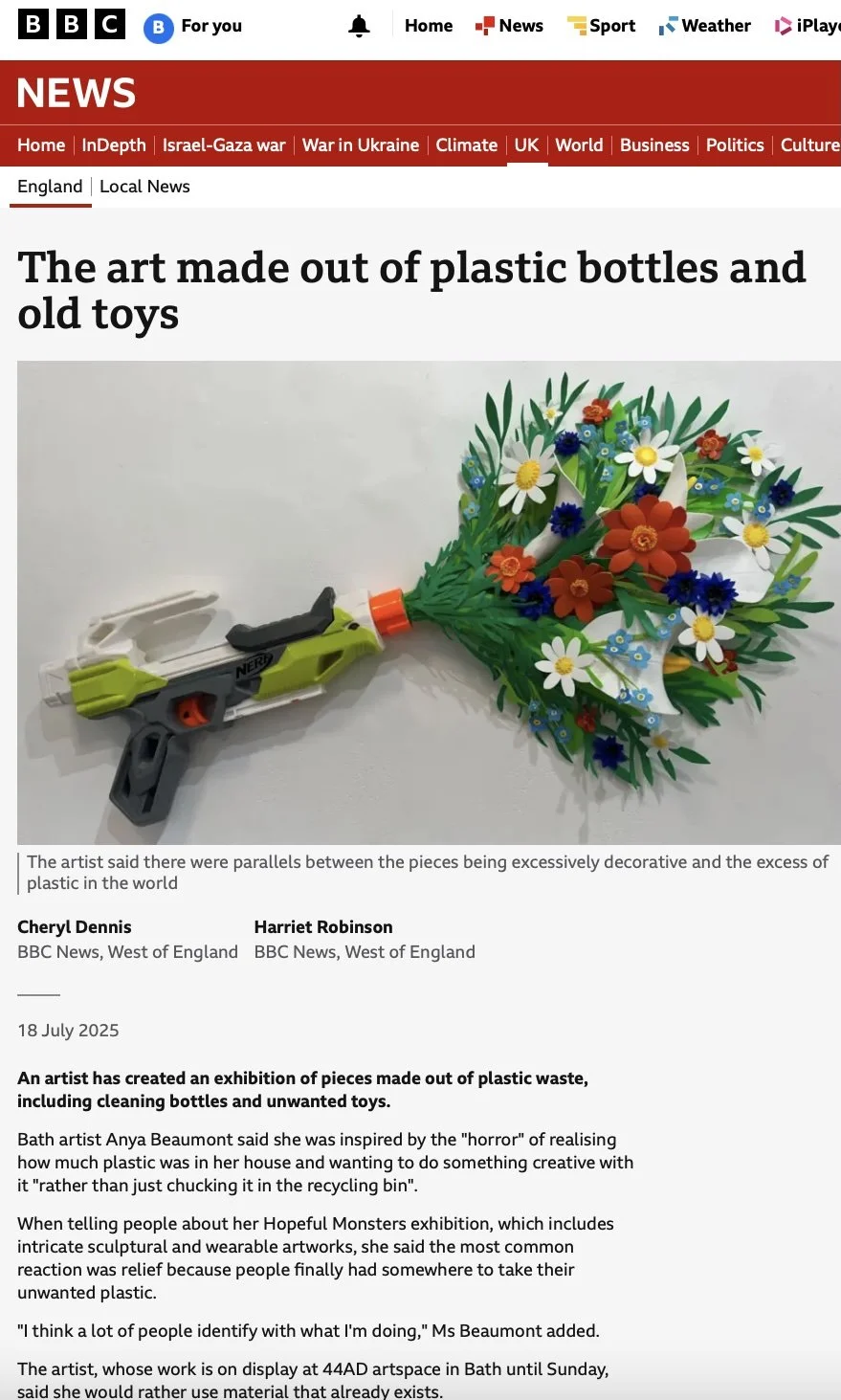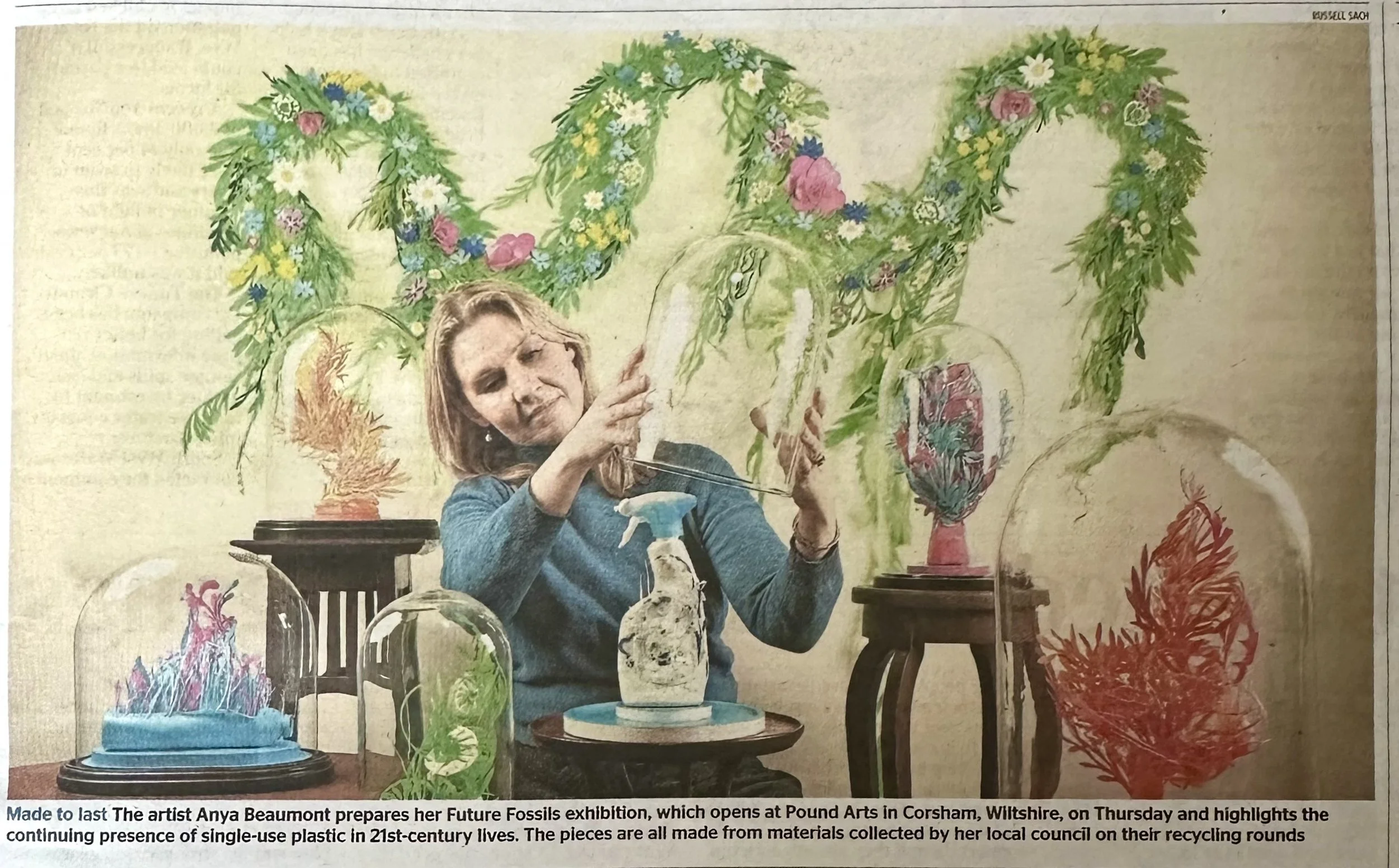https://www.bbc.co.uk/news/articles/cx2k78kd3vko - for full article on BBC News Website.
The Times Newspaper (print edition), Tuesday 30 April 2024. Photo by Russell Sach.
Future Fossils May 2024
Text on Future Fossils by Katie Ackril, 2024
In 1907, Leo Hendrik Baekeland created the first fully synthetic plastic. Dubbed The Material of a Thousand Uses, Bakelite was easily mass-produced into desirable products with accessible consumer price-tags. In the 1930s, the development of Perspex, polyethylene, Nylon, Vinyl and Teflon followed Baekeland’s invention. Post-war manufacturing preferred these cheap and convenient plastics over glass, metal and paper. The “Age of Plastic” was ushered in with enthusiasm, but this change quickly led to a dark legacy for these promising new materials.
In Anya Beaumont’s studio, overflowing bags of containers reveal humanity’s reliance on single-use plastics. Once filled with household cleaning products, toiletries and food produce, the discarded items are piled up in a succession of punchy pinks, fluorescent yellows and brilliant blues. Images from Greenpeace and the National Geographic are called to mind. Children in the Philippines play among piles of plastic, and the UK’s recycling washes up on the shores of Malaysia.
Yet, in the artist’s studio these problematic vessels take on the identity of a creative medium, in the manner of paints in a painter’s studio, or fabrics for an upholsterer. Each bottle or tub has potential to be just the right colour, shape or malleability for the next creation. Once selected, it is carefully cut to shape and manipulated into a completely new form. In Anya’s studio, discarded plastics await a second life.
Anya’s exploration of pre-used plastics as a creative medium began in 2019, with the inclusion of a small sculpture in the exhibition Flourish at Pound Arts. For the first time, Anya’s intricate contemporary-baroque style was transformed through the smooth sheen and block colours of recycled plastic. This new approach was fully realised in 2023 with the completion of The Four, from the ongoing Hopeful Monsters series. Made entirely from pre-used plastics, and referring to the four elements, these sculptures signal to human abuses of the planet. Yet The Four are not here to admonish us. Vibrant and playful, they roll in on their wheels of discarded kids’ toys, bringing hope for a better future.
The most recent additions to the Hopeful Monsters series move away from a solely environmental narrative. In The Mother, The Promise and The Wish, repurposed domestic furniture and references to vessels suggest anxieties bound up with pregnancy and motherhood. For Anya, feelings of unease are connected with her fear of birds. Feathers are made from recycled shower gel bottles of deep black tones, which reflect light in a manner suggesting the movement of a slick glossy coat. Dark, surreal and bodily, these pieces are imbued with an uncomfortable, psychological presence.
Anya’s ability to make plastic appear to live and breathe is exemplified by the series that inspires the exhibition’s title. The Future Fossils are vibrant symphonies of colour and organic forms, which seemingly pulsate with life. Yet they are contained within bell jars, calling to mind a Victorian vogue for collecting and displaying natural history specimens. This presentation provokes questions about what we choose to conserve, and what is preserved by its very nature. It asks how this “Age of Plastic” will be remembered and looked upon in the future. At the same time, we are reminded that the power to decide has somewhat been forfeited. After all, a key attribute that made plastics so desirable at the beginning of the 20th Century, is the very thing that makes them so problematic today: their durability.
Text on 'Mapping Muswell - An N10 Paper project' by Alice Lobb
Maps have traditionally been projected as a 'view from nowhere' produced objectively as a tool for way finding. The increased accessibility to information and technology in the last twenty years has opened up the process of map-making to become a more embodied practice in which counter cartographies are able to challenge the status quo. In the hands of artists, mapping becomes a practice with which to personally explore the different ways we live our lives, and readdress established power relationships, giving agency to people and places previously left off of the map.'
For Mapping Muswell Anya Beaumont has created a sculptural relief map that combines her own intricate working methods and interpretation of the locality with materials and memories from residents of this London area. The artist has participated in interviews, meetings and presentations in the neighbourhood and produced a blog and website to document the process. The result is a multi-faceted creative project that mediates between past, present and future.
The artist's starting point for the work are maps of the area, a contemporary street map and one from 1898 from which she cuts away everything but the streets to create a paper filigree. This fragile paper cut is then suspended and the artist traces its shadow onto paper to create an iteration of the area. This is then cut and the process is repeated, the multiple layers taking on their own form, an individual route of the neighbourhood. Each layer is produced from donated paper from local libraries, schools, businesses and public buildings. This foundation to the relief includes extracts from books, snippets of letters, cuts of wallpaper, strips of sheet music, all revealing fragments of the life of the area and its residents.
Within these folds and shadows the viewer can find smaller details, inspired by the artist's own wanderings. A network of delicate branches creep in all directions from the body of a tree in Coldfall woods, mimicking the road arteries in which it is nestled. An old menu from the Clissold Arms is transformed into the entrance gates of the old hospital on Coppetts Road. The care taken to cut this delicate frame reflecting the building's former use and the fragility of the lives nursed there. These are weaved between photocopied maps with broken, wobbly letters of the street names, that echo the surface of the roads, the marks made are traces of the people that have travelled them.
Anya's energy and enthusiasm has enabled news of the project to travel and her collection of stories, memories and fantasies of the area has grown through her contact with different communities. The 'map-me' activity which she took to local schools, residencies at the Local Gallery and Muswell Hill Library and other community events encouraged people to draw or write about their favourite spots. Combined with her fragile filigrees these personal documents created by residents of all ages add colour and local characters to the work.
At a time when regeneration in some parts of London threatens to erase or at least sanitise spaces in which communities can share such memories and experiences, Anya's work is an important reminder of the colour and depth that should be protected. Led by the subjectivity of the map-maker and the people she has met this project is not an attempt to map everything in the area nor preserve a vision of an ideal community. Rather it combines materials old and new to create a unique mapping of the neighbourhood, a new space, that alludes to the past, represents the present and points towards possible futures.
Text on the Re-Vision (Muswell Hill) Exhibition by Alice Lobb
At first glance I see stark contrasts; multicoloured growths sprawling up monotone columns, intricate handcraft alongside peeling paintwork, organic sculptural wreaths hanging in concrete jungles. I blink and there are heads of worldly bearded figures, short-legged gremlins, the tails of fantastical sea creatures. As my eyes focus on the intricate patterns of the paper cut sculptures I am hypnotised by their detail, following each curve and crevice as it undulates over the 1940s stonework upon which it has taken temporary residence.
Artists have been applauded for centuries for their ability to see something new in the otherwise ordinary, introducing new ideas and ways of looking. By presenting a radical new impression of the world and reframing the everyday, some are able to make the ordinary extraordinary and draw attention to what otherwise might go unnoticed. In a contemporary context this ability to re-frame or revise a place is a well known formula for urban regeneration; artists move to a formerly overlooked area and a creative community grows followed by cultural tourists and often increased property prices. Artists have a unique ability to make use of their local resources to offer an alternative viewpoint on a place and to question its perceived value and beauty.
For Re-vision Beaumont has looked again at Muswell Hill where she lives and works. Following a recent mapping project in the area, funded by Arts Council England, the artist has created new paper sculptures which she has then photographed in the locale. This area of London is not a place that seems overlooked, or in need of regeneration: its green spaces, village feel and views of the city make it a desirable location to live. Beginning with this more celebrated view, Beaumont photographed Victorian architectural pediments on the area's well known Fortis Green Road and Broadway. She then involved the local community through a general call out for paper, a method she has used in previous work. The images of the stonework are then printed onto these collected drawings, receipts and letters, transposing their once grand elegance onto fragments of the lives of everyday residents. The artist then laboriously hand cuts the images and layers the resulting delicate paper, to slowly build organic ephemeral sculptures derived from elegant masonry.
The journey of these sculptures continues as Beaumont takes them back into the local area. Led by an appreciation for fine brickwork the artist photographs the sculptures in 1940s housing blocks and back road mews', away from the well trodden roads from which they were originally lifted. A new perspective on what would otherwise be familiar sites is presented in the resulting giclee prints. The alien paper column signposts the eye to carefully composed doorways and inviting sloped paths. It crawls up geometric stairways and neatly plants itself into overlooked corners whilst the circular wreath made from recycled paper celebrates incidental architectural features and textured tarmac. When the artist talks about this method of taking these transitory sculptures into the urban environment she recalls the strange glances, unpredictable weather and fruitful conversations encountered. The absurdity of her making process is subtly translated into the resulting images and it is this that disrupts and distorts our normal view of these otherwise unremarkable sites.
The paper sculptures are like punctuation in an urban landscape; juxtaposing past and present and making extraordinary otherwise everyday scenes the multi-layered images ask us to stop and look again at our own surroundings. By relocating historical fancy onto and then into the present everyday this series of photographs provide a gap in which to slow down and reconsider or revise how architecture, people, objects and design combine to define a place - what is it that makes them beautiful and how do they retain this value?'
Alice Lobb organises exhibitions for the Barbican. She also writes about contemporary art.
Pedestal (2013) Hand cut framed paper sculpture made in response to Muswell Hill’s decorative architecture from pre-used paper collected from the area.



